Human Rights Reflective Blog: Asylum Seekers, Week 10 Analysis
VerifiedAdded on 2021/06/16
|5
|1033
|33
Journal and Reflective Writing
AI Summary
This reflective blog post examines the human rights of asylum seekers, focusing on the definition of a refugee according to the 1951 Refugee Convention, and the rights afforded to them. It outlines the Australian government's obligations in the reception and resettlement of asylum seekers and references the arguments of Tania Penovic regarding the treatment of refugees. The blog addresses key aspects such as the right to seek asylum, freedom of movement, the right to public assistance, and the obligation of non-refoulement. It differentiates between refugees and other displaced persons, emphasizing the importance of well-substantiated fear of persecution. The blog also discusses the non-refoulement principle and the implications of Article 31(1) regarding illegal entry. Finally, it touches upon the legal case of Lim V's, highlighting the complexities of offshore processing arrangements and the importance of treating asylum seekers humanely.
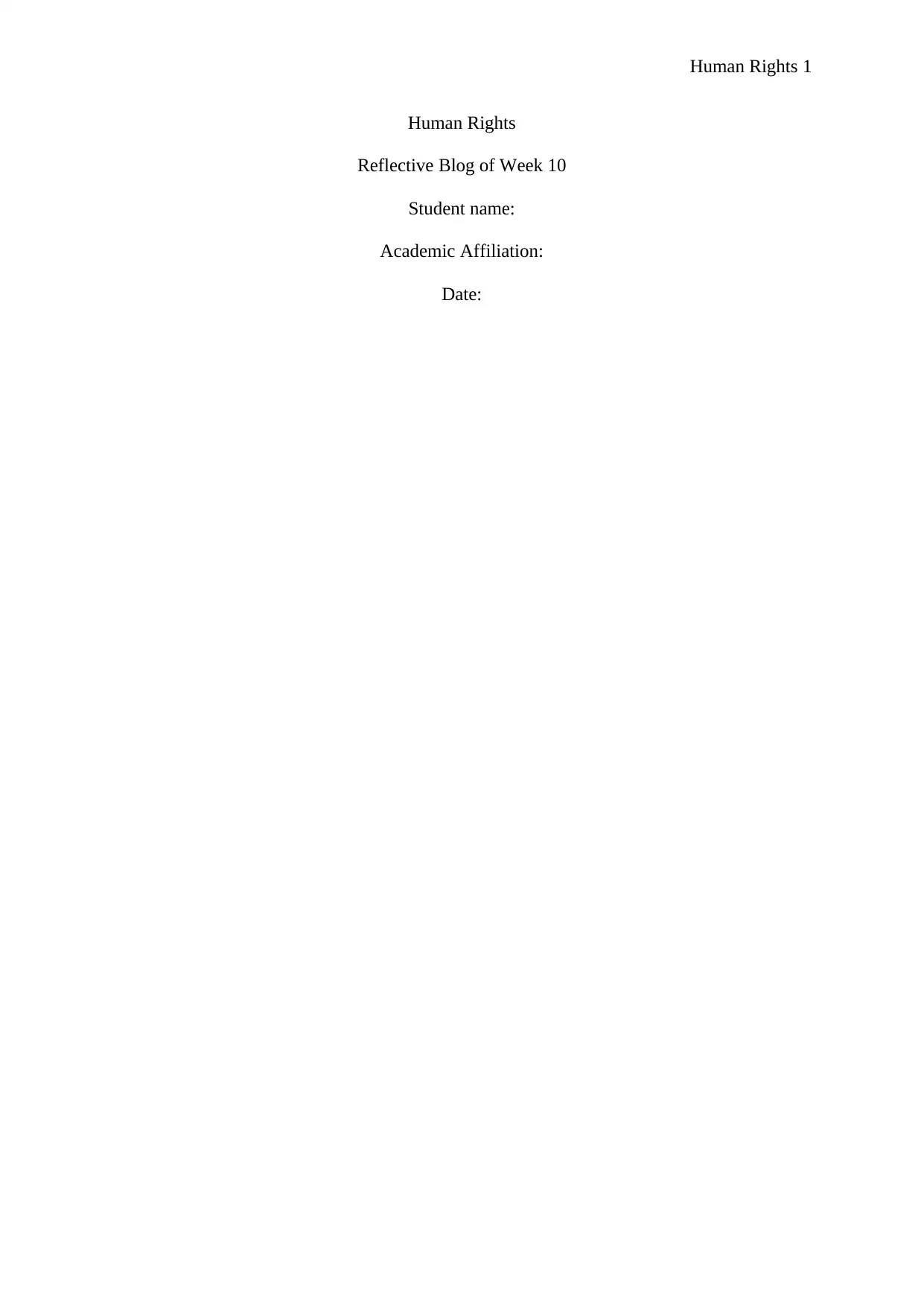
Human Rights 1
Human Rights
Reflective Blog of Week 10
Student name:
Academic Affiliation:
Date:
Human Rights
Reflective Blog of Week 10
Student name:
Academic Affiliation:
Date:
Paraphrase This Document
Need a fresh take? Get an instant paraphrase of this document with our AI Paraphraser
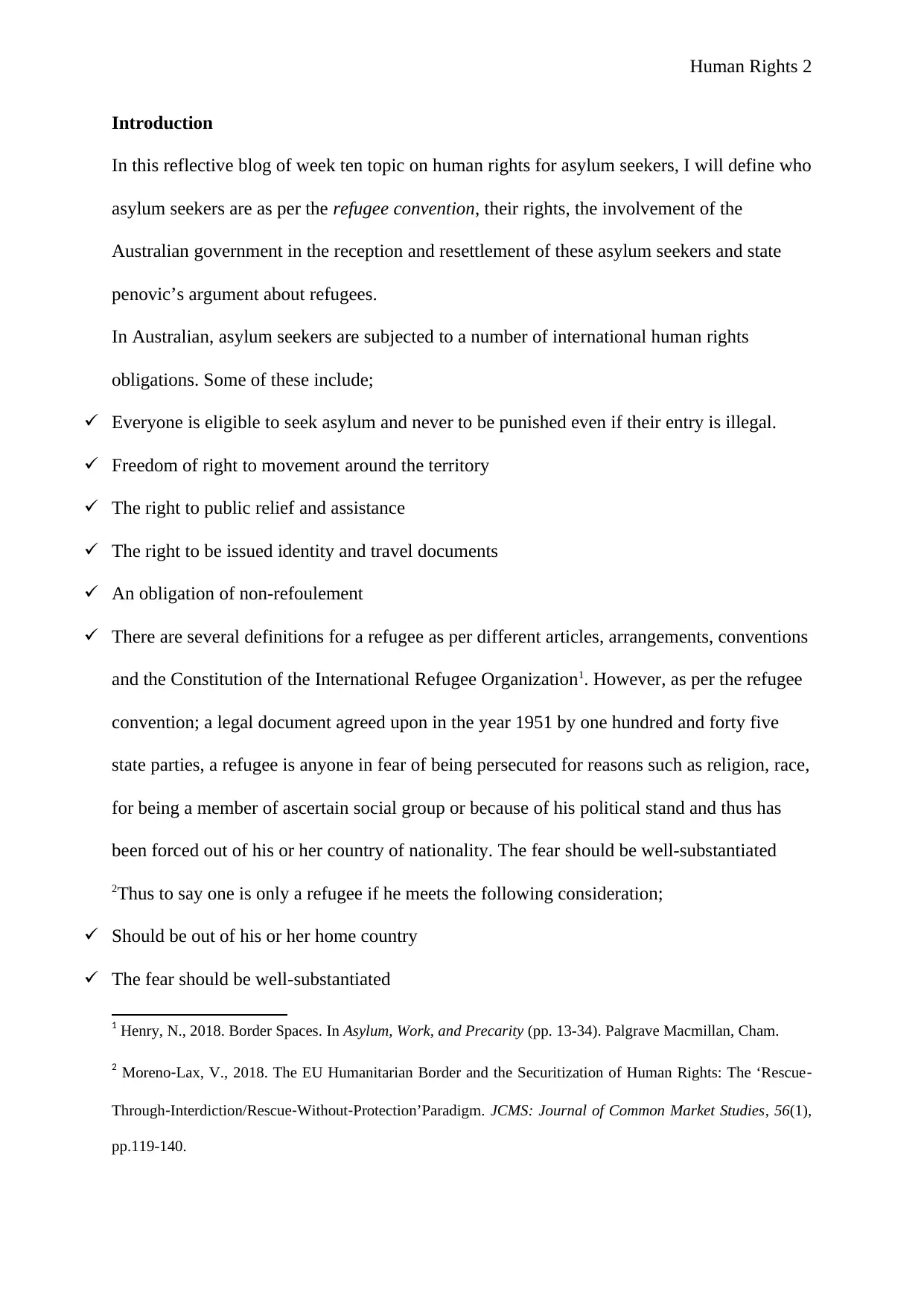
Human Rights 2
Introduction
In this reflective blog of week ten topic on human rights for asylum seekers, I will define who
asylum seekers are as per the refugee convention, their rights, the involvement of the
Australian government in the reception and resettlement of these asylum seekers and state
penovic’s argument about refugees.
In Australian, asylum seekers are subjected to a number of international human rights
obligations. Some of these include;
Everyone is eligible to seek asylum and never to be punished even if their entry is illegal.
Freedom of right to movement around the territory
The right to public relief and assistance
The right to be issued identity and travel documents
An obligation of non-refoulement
There are several definitions for a refugee as per different articles, arrangements, conventions
and the Constitution of the International Refugee Organization1. However, as per the refugee
convention; a legal document agreed upon in the year 1951 by one hundred and forty five
state parties, a refugee is anyone in fear of being persecuted for reasons such as religion, race,
for being a member of ascertain social group or because of his political stand and thus has
been forced out of his or her country of nationality. The fear should be well-substantiated
2Thus to say one is only a refugee if he meets the following consideration;
Should be out of his or her home country
The fear should be well-substantiated
1 Henry, N., 2018. Border Spaces. In Asylum, Work, and Precarity (pp. 13-34). Palgrave Macmillan, Cham.
2 Moreno‐Lax, V., 2018. The EU Humanitarian Border and the Securitization of Human Rights: The ‘Rescue‐
Through‐Interdiction/Rescue‐Without‐Protection’Paradigm. JCMS: Journal of Common Market Studies, 56(1),
pp.119-140.
Introduction
In this reflective blog of week ten topic on human rights for asylum seekers, I will define who
asylum seekers are as per the refugee convention, their rights, the involvement of the
Australian government in the reception and resettlement of these asylum seekers and state
penovic’s argument about refugees.
In Australian, asylum seekers are subjected to a number of international human rights
obligations. Some of these include;
Everyone is eligible to seek asylum and never to be punished even if their entry is illegal.
Freedom of right to movement around the territory
The right to public relief and assistance
The right to be issued identity and travel documents
An obligation of non-refoulement
There are several definitions for a refugee as per different articles, arrangements, conventions
and the Constitution of the International Refugee Organization1. However, as per the refugee
convention; a legal document agreed upon in the year 1951 by one hundred and forty five
state parties, a refugee is anyone in fear of being persecuted for reasons such as religion, race,
for being a member of ascertain social group or because of his political stand and thus has
been forced out of his or her country of nationality. The fear should be well-substantiated
2Thus to say one is only a refugee if he meets the following consideration;
Should be out of his or her home country
The fear should be well-substantiated
1 Henry, N., 2018. Border Spaces. In Asylum, Work, and Precarity (pp. 13-34). Palgrave Macmillan, Cham.
2 Moreno‐Lax, V., 2018. The EU Humanitarian Border and the Securitization of Human Rights: The ‘Rescue‐
Through‐Interdiction/Rescue‐Without‐Protection’Paradigm. JCMS: Journal of Common Market Studies, 56(1),
pp.119-140.
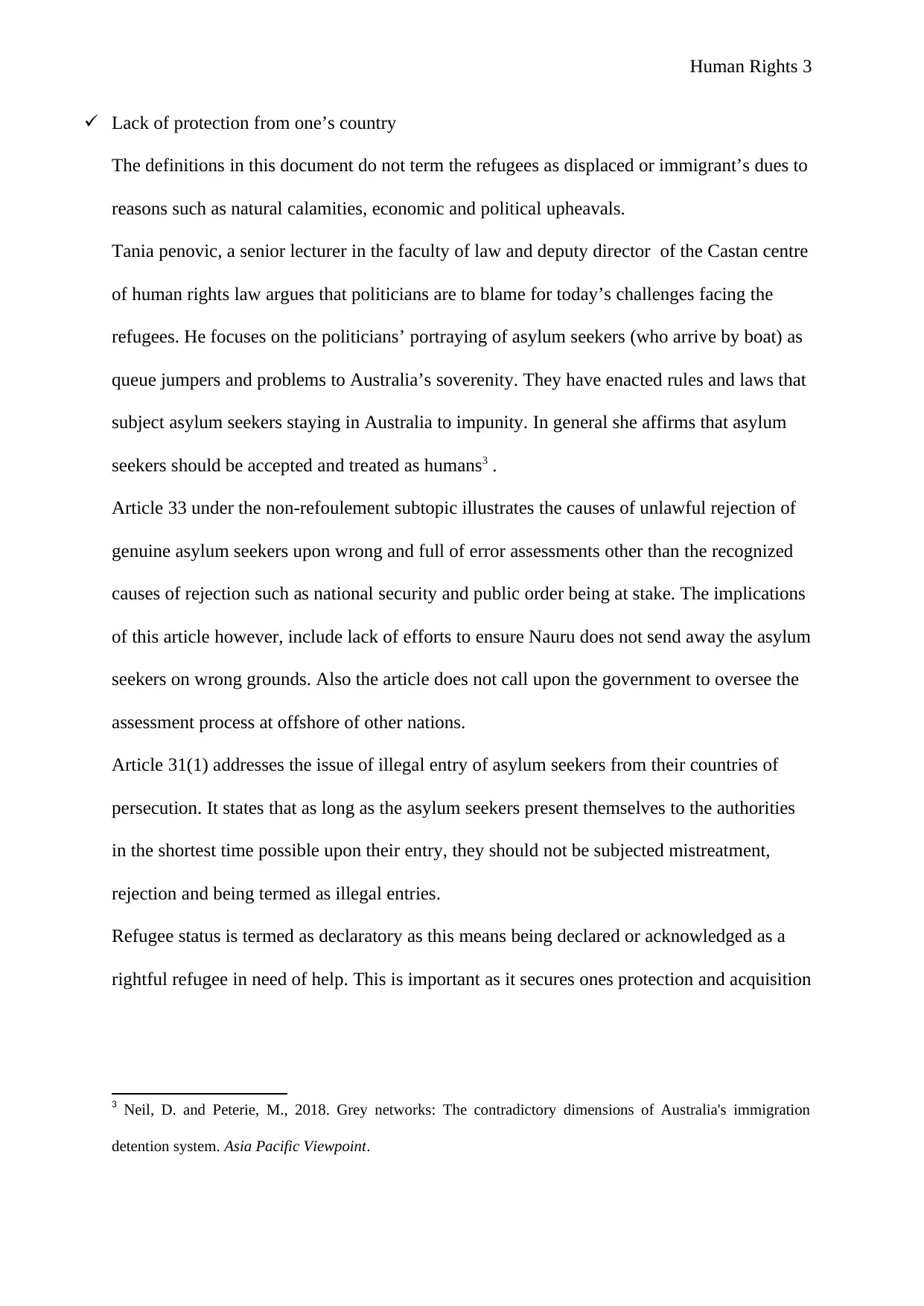
Human Rights 3
Lack of protection from one’s country
The definitions in this document do not term the refugees as displaced or immigrant’s dues to
reasons such as natural calamities, economic and political upheavals.
Tania penovic, a senior lecturer in the faculty of law and deputy director of the Castan centre
of human rights law argues that politicians are to blame for today’s challenges facing the
refugees. He focuses on the politicians’ portraying of asylum seekers (who arrive by boat) as
queue jumpers and problems to Australia’s soverenity. They have enacted rules and laws that
subject asylum seekers staying in Australia to impunity. In general she affirms that asylum
seekers should be accepted and treated as humans3 .
Article 33 under the non-refoulement subtopic illustrates the causes of unlawful rejection of
genuine asylum seekers upon wrong and full of error assessments other than the recognized
causes of rejection such as national security and public order being at stake. The implications
of this article however, include lack of efforts to ensure Nauru does not send away the asylum
seekers on wrong grounds. Also the article does not call upon the government to oversee the
assessment process at offshore of other nations.
Article 31(1) addresses the issue of illegal entry of asylum seekers from their countries of
persecution. It states that as long as the asylum seekers present themselves to the authorities
in the shortest time possible upon their entry, they should not be subjected mistreatment,
rejection and being termed as illegal entries.
Refugee status is termed as declaratory as this means being declared or acknowledged as a
rightful refugee in need of help. This is important as it secures ones protection and acquisition
3 Neil, D. and Peterie, M., 2018. Grey networks: The contradictory dimensions of Australia's immigration
detention system. Asia Pacific Viewpoint.
Lack of protection from one’s country
The definitions in this document do not term the refugees as displaced or immigrant’s dues to
reasons such as natural calamities, economic and political upheavals.
Tania penovic, a senior lecturer in the faculty of law and deputy director of the Castan centre
of human rights law argues that politicians are to blame for today’s challenges facing the
refugees. He focuses on the politicians’ portraying of asylum seekers (who arrive by boat) as
queue jumpers and problems to Australia’s soverenity. They have enacted rules and laws that
subject asylum seekers staying in Australia to impunity. In general she affirms that asylum
seekers should be accepted and treated as humans3 .
Article 33 under the non-refoulement subtopic illustrates the causes of unlawful rejection of
genuine asylum seekers upon wrong and full of error assessments other than the recognized
causes of rejection such as national security and public order being at stake. The implications
of this article however, include lack of efforts to ensure Nauru does not send away the asylum
seekers on wrong grounds. Also the article does not call upon the government to oversee the
assessment process at offshore of other nations.
Article 31(1) addresses the issue of illegal entry of asylum seekers from their countries of
persecution. It states that as long as the asylum seekers present themselves to the authorities
in the shortest time possible upon their entry, they should not be subjected mistreatment,
rejection and being termed as illegal entries.
Refugee status is termed as declaratory as this means being declared or acknowledged as a
rightful refugee in need of help. This is important as it secures ones protection and acquisition
3 Neil, D. and Peterie, M., 2018. Grey networks: The contradictory dimensions of Australia's immigration
detention system. Asia Pacific Viewpoint.
⊘ This is a preview!⊘
Do you want full access?
Subscribe today to unlock all pages.

Trusted by 1+ million students worldwide
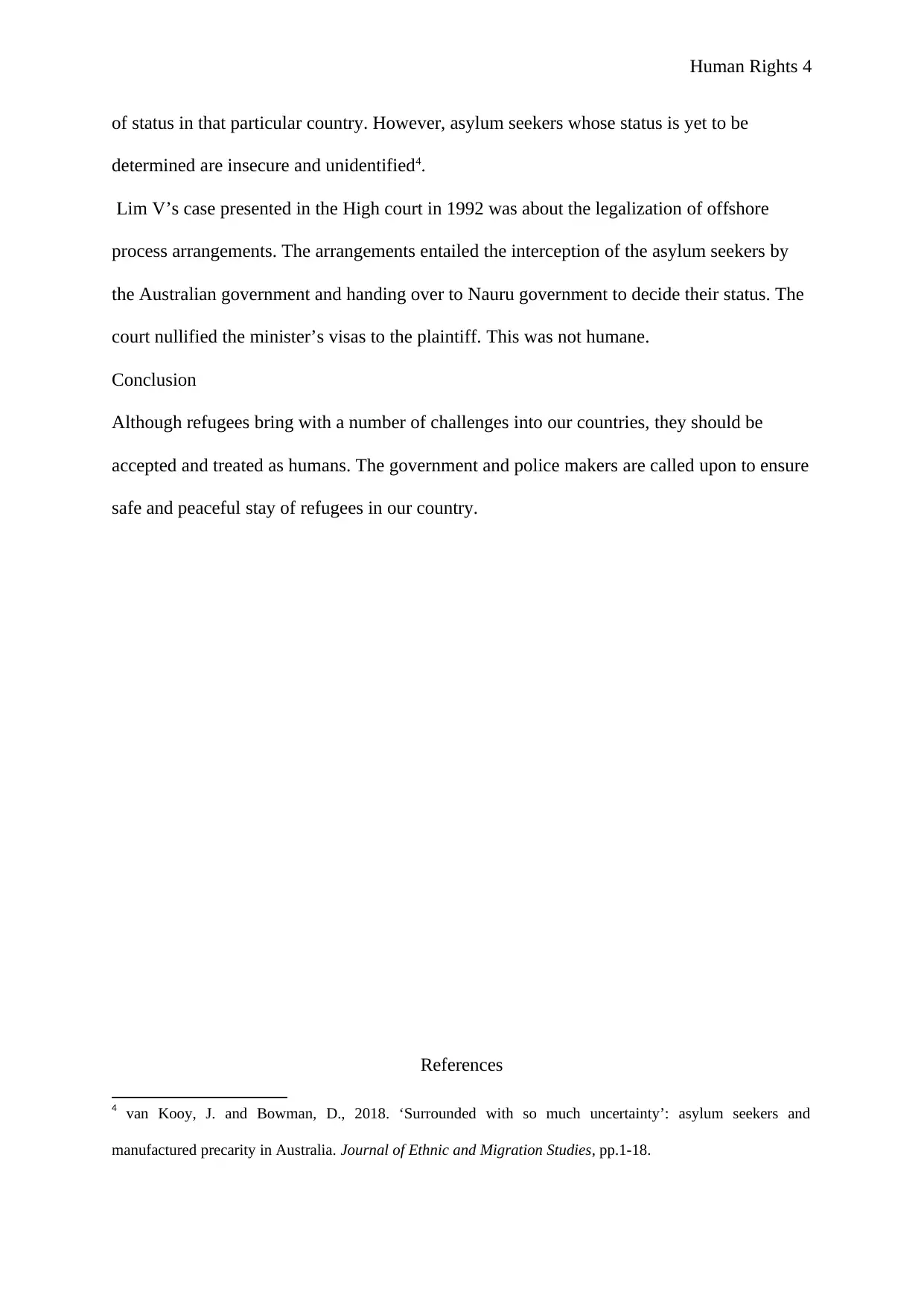
Human Rights 4
of status in that particular country. However, asylum seekers whose status is yet to be
determined are insecure and unidentified4.
Lim V’s case presented in the High court in 1992 was about the legalization of offshore
process arrangements. The arrangements entailed the interception of the asylum seekers by
the Australian government and handing over to Nauru government to decide their status. The
court nullified the minister’s visas to the plaintiff. This was not humane.
Conclusion
Although refugees bring with a number of challenges into our countries, they should be
accepted and treated as humans. The government and police makers are called upon to ensure
safe and peaceful stay of refugees in our country.
References
4 van Kooy, J. and Bowman, D., 2018. ‘Surrounded with so much uncertainty’: asylum seekers and
manufactured precarity in Australia. Journal of Ethnic and Migration Studies, pp.1-18.
of status in that particular country. However, asylum seekers whose status is yet to be
determined are insecure and unidentified4.
Lim V’s case presented in the High court in 1992 was about the legalization of offshore
process arrangements. The arrangements entailed the interception of the asylum seekers by
the Australian government and handing over to Nauru government to decide their status. The
court nullified the minister’s visas to the plaintiff. This was not humane.
Conclusion
Although refugees bring with a number of challenges into our countries, they should be
accepted and treated as humans. The government and police makers are called upon to ensure
safe and peaceful stay of refugees in our country.
References
4 van Kooy, J. and Bowman, D., 2018. ‘Surrounded with so much uncertainty’: asylum seekers and
manufactured precarity in Australia. Journal of Ethnic and Migration Studies, pp.1-18.
Paraphrase This Document
Need a fresh take? Get an instant paraphrase of this document with our AI Paraphraser
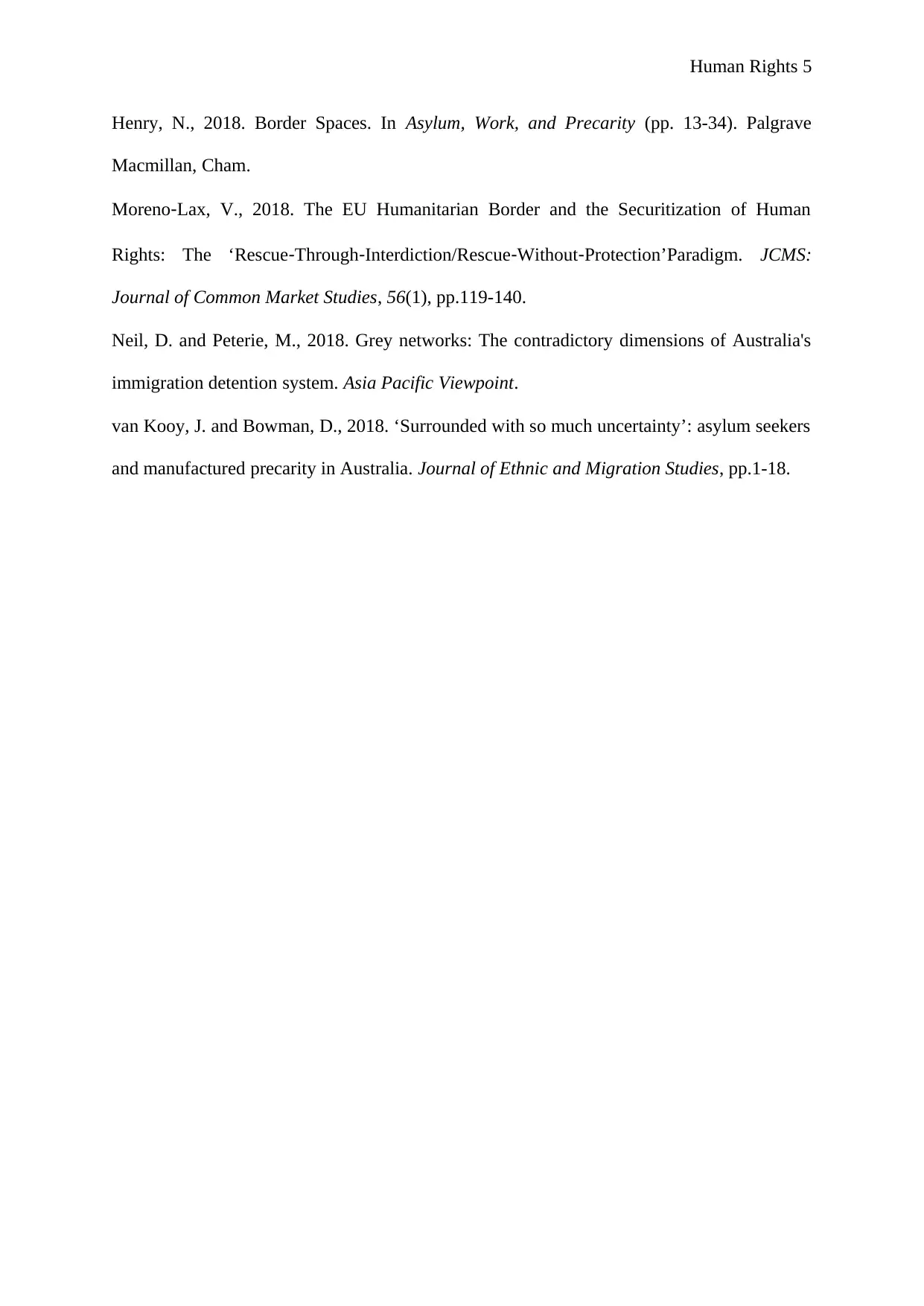
Human Rights 5
Henry, N., 2018. Border Spaces. In Asylum, Work, and Precarity (pp. 13-34). Palgrave
Macmillan, Cham.
Moreno‐Lax, V., 2018. The EU Humanitarian Border and the Securitization of Human
Rights: The ‘Rescue‐Through‐Interdiction/Rescue‐Without‐Protection’Paradigm. JCMS:
Journal of Common Market Studies, 56(1), pp.119-140.
Neil, D. and Peterie, M., 2018. Grey networks: The contradictory dimensions of Australia's
immigration detention system. Asia Pacific Viewpoint.
van Kooy, J. and Bowman, D., 2018. ‘Surrounded with so much uncertainty’: asylum seekers
and manufactured precarity in Australia. Journal of Ethnic and Migration Studies, pp.1-18.
Henry, N., 2018. Border Spaces. In Asylum, Work, and Precarity (pp. 13-34). Palgrave
Macmillan, Cham.
Moreno‐Lax, V., 2018. The EU Humanitarian Border and the Securitization of Human
Rights: The ‘Rescue‐Through‐Interdiction/Rescue‐Without‐Protection’Paradigm. JCMS:
Journal of Common Market Studies, 56(1), pp.119-140.
Neil, D. and Peterie, M., 2018. Grey networks: The contradictory dimensions of Australia's
immigration detention system. Asia Pacific Viewpoint.
van Kooy, J. and Bowman, D., 2018. ‘Surrounded with so much uncertainty’: asylum seekers
and manufactured precarity in Australia. Journal of Ethnic and Migration Studies, pp.1-18.
1 out of 5
Related Documents
Your All-in-One AI-Powered Toolkit for Academic Success.
+13062052269
info@desklib.com
Available 24*7 on WhatsApp / Email
![[object Object]](/_next/static/media/star-bottom.7253800d.svg)
Unlock your academic potential
Copyright © 2020–2025 A2Z Services. All Rights Reserved. Developed and managed by ZUCOL.





